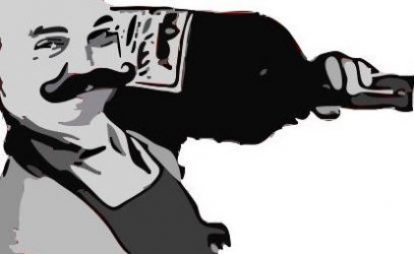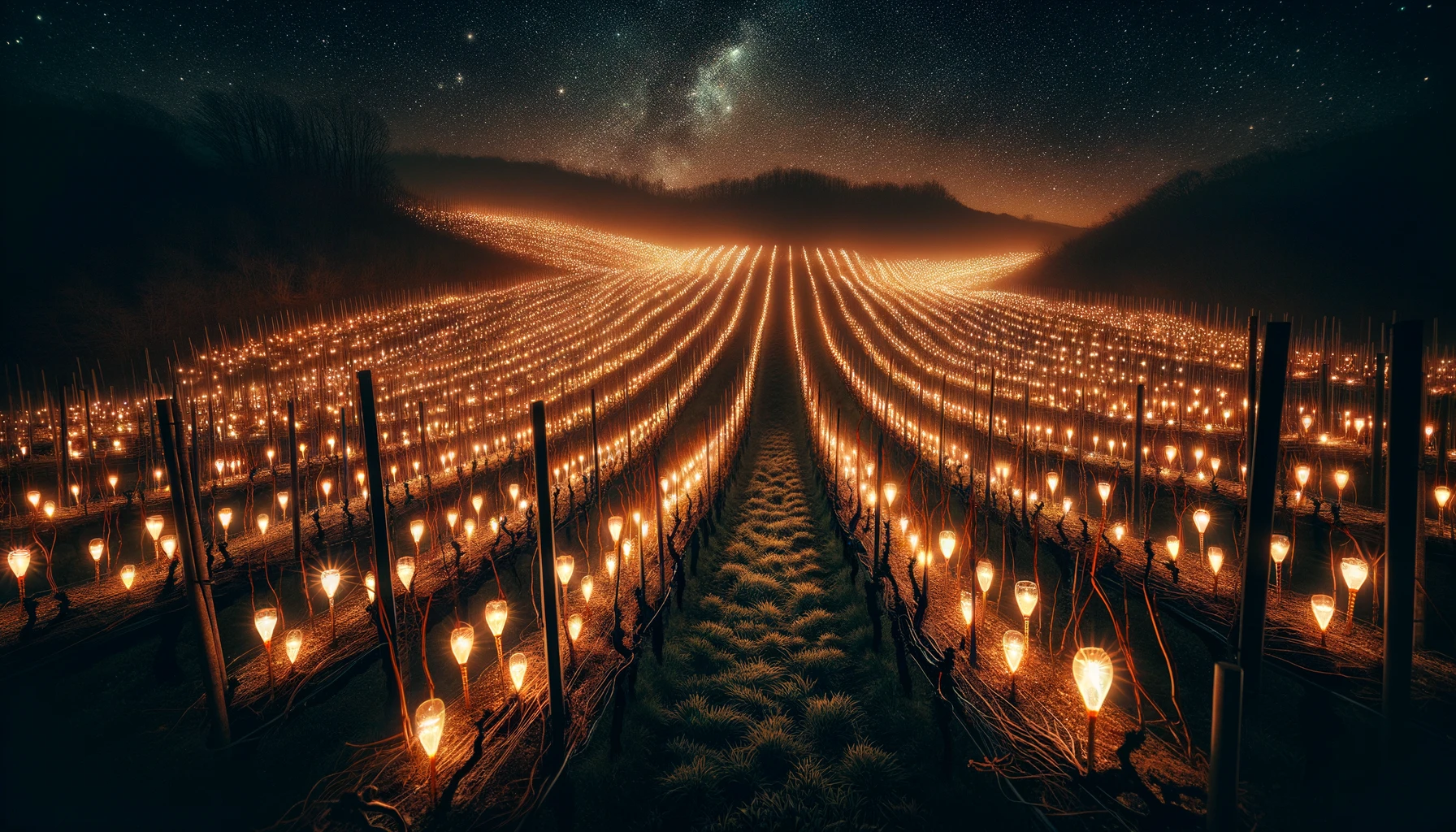I just got back from a week visiting the vineyards of Armenia, which has experienced unseasonal high temperatures at the end of April, bordering and exceeding 30 degrees Celsius. While on the trip, one of my friends sent me news about the devastating damages to the vineyards of Chablis due to a hailstorm. The extreme weather events have not been confined to Armenia, as various wine-producing regions across Europe have been wrestling with their own climatic challenges. This article explores the severe impact of these events on the vineyards in Chablis, France, as well as in Spain, Austria, and Germany and what vintners can do about it.
The Cold Grip of April in France
The last days of April brought frosty nights that triggered significant concern across French wine regions. To mitigate potential damage, winemakers employed traditional techniques such as burning hay bales in the vineyards. Despite these efforts, the success varied significantly across different areas. In smaller wine regions like Jura, approximately 40% of vineyards were affected, reminiscent of the harsh frost of 2017. The situation was grimmer in Cahors, where damages extended to around 90% of vineyards, according to Vitisphere. However, better-known regions like Bordeaux, managed to keep damages to a minimum, thanks to better preparation and responsive measures. Christophe Chateau from the Conseil Interprofessionel des Vins de Bordeaux (CIVB) reported only minimal impacts, according to Meininger.
Hail Devastation in Chablis
As the winemakers in Chablis were beginning to recover from the frosts, a severe hailstorm on 1st May struck the vineyards of Chablis as well as Irancy in the Yonne region, causing localized but significant damage. The storm occurred on the night from Monday to Tuesday, impacting about 10 to 15% of the vineyard area, with hailstones the size of ping pong balls and bigger. Notably, the damage concentrated in prestigious areas of Chablis, including Grand Crus such as Les Clos and Blanchots, as well as some Premier Crus like Montmains, Butteaux, Forêts, and Montée de Tonnerre. The hailstorm followed a narrow corridor approximately 200 meters wide, extending from Irancy through Chablis to Fyé. Particularly hard-hit were the plots in Courgis. Despite the timing of the storm, which came as the grapes had just reached maturity, the potential for the overall harvest remains cautiously optimistic. During the storm, large hailstones fell for about ten minutes, accompanied by substantial rainfall.
The aftermath raised concerns about the possible development of fungal diseases, given the proximity to the harvest season, potentially pushing winemakers to begin picking earlier than planned. In some vineyards, notably those not directly in the path of the worst hail, the damage was more to the foliage than to the grape bunches themselves, suggesting that some of the vineyards might still achieve a reasonable harvest.
Overall, the impact of the hail was severe in specific sectors, especially those with Premier and Grand Cru designations. The storm added to the challenges faced by winemakers, who are now assessing the extent of the damage and preparing for an earlier harvest to salvage what remains of this year’s crop. The weather event underscores the vulnerability of wine regions to climatic extremes, which can alter the course of an entire vintage within just a few hours. While the exact damage will also become apparent over time, local winemakers, estimated a crop loss of 70% or more in some areas, exacerbated by subsequent heavy rains and flooding. While it sounds like a freak event, Chablis is not new to the havoc created by hail and only in 2016severe hailstorms caused such damage to its vineyards and those of nearby regions that the country’s farming federation to declared an emergency.
A Widespread Calamity
We have been discussing the effects of extreme weather events on several occasions. In fact, this is far from an isolated event but rather a recurring theme, yet seemingly with more devastating consequences and at a faster rate.
For instance, frosts were similarly destructive in Spain. Regions such as Rioja saw over 4,000 hectares affected. In Castilla y León and Castilla-La Mancha, the impact was profound, with significant portions of vineyard acreage suffering damage, as reported by Agroseguro. The total damaged area reported across Spain spanned approximately 18,200 hectares.
Recent reports from Austria have detailed significant financial damage to the agricultural sectors due to extreme weather, with an estimated total of €56 million in losses. The majority of this damage impacted fruit cultivation, accounting for €44 million, while the wine industry incurred around €12 million in losses. The most severely affected region was Styria, suffering €37 million in damages, of which €5 million affected the wine sector. Lower Austria followed with an estimated €17 million in damages. In specific detail, early grape varieties such as Muskateller, Blauer Wildbacher, Chardonnay, and Zweigelt in lower Styria and premier sites faced considerable frost damage exacerbated by heavy snowfall. This led to increased breakage in the already elongated shoots, with extensive damage reported across Lower Austria, particularly in the districts of Krems and Tulln. Even in areas typically resistant to frost, such as Kamptal, the upper Wachau, Wagram, and parts of Weinviertel, temperatures dropped to as low as -4°C (24.8°F), significantly impacting vineyard sites not usually prone to frost due to cold air currents.
Germany’s vineyards were also hard-hit. The German wine magazine DDW and reports from local wineries highlighted the severe frost impacts in regions like Franconia, Hessische Bergstraße, and Mosel. The cold snap in these areas led to widespread damage, with some wineries experiencing up to 100% crop losses. Across the affected regions, winemakers took various steps to protect their vineyards. These included using frost candles and fires, though the efficacy varied. For instance, in Germany, despite the use of frost candles, the severe cold penetrated beyond the surface, rendering these measures less effective.
Fighting an Uphill Battle?
While it might sound like winegrowers were facing a battle, they are bound to lose, it is not all doom and gloom. First of all, I cannot stress enough the respect I have for the farmers that put themselves on the line, working with an element as unpredictable as nature. Well, while it is entirely true what I said about the respect I have, you may say that the weather eventually is not as unpredictable as I just claimed. Yet, it is a gruesome opponent, often acting so quickly that even the best preparations are not enough. Because measures can be taken as we have highlighted on a piece on how vintners battle frost.
Equally, vintners have developed various strategies to protect their vineyards from hail and the subsequent damage it can cause. Hail can be particularly devastating for vineyards as it can destroy grape crops, damage the vines, and lead to long-term setbacks in vine growth.
The most effective and widespread methods is the installation of hail nets over the vines. These nets provide a physical barrier against hailstones, significantly reducing the damage to the plants below. They can be permanently installed or rolled out only during the season when hail is most likely.
Another option I came across my recent trip to Armenia are hail cannons. These devices work in different ways, for instance by attempting to disrupt the formation of hailstones within storm clouds by emitting shockwaves into the atmosphere. Whilst visiting a vineyard, I came to experience the cannons first hand, when not far from us in another area a storm was approaching and loud gun shots could be heard. Yet, event though the effectiveness of hail cannons is debated among scientists, but some vintners continue to use them as a preventive measure and not just in Armenia.
It can also help planting vine rows in the direction of prevailing winds as it allows the wind to blow hailstones away from the more sensitive and exposed parts of the vines. If, however, the damage is done, many producers can rely on insurance as purchasing crop insurance is critical for mitigating financial risk associated with hail damage. In this way, it ensures that the vintner can recover some of the financial losses from damaged crops. At the same time, it is essential for vintners after hail damage to quickly tend to injured vines to prevent diseases and pests from entering the plants. Pruning damaged areas and applying fungicides can help the vines recover more effectively and prepare them for the next growing season.
Yet, all these measures just as the ways to battle frost that we already discussed often are only of limited use. Hence, it is might not be the worst thing to keep that in mind when you have your next glass of wine and might help you enjoy all the more…




